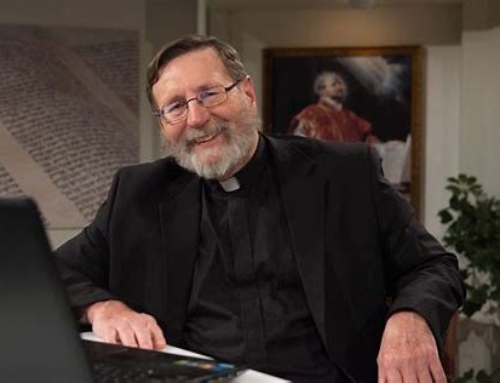Some years ago I was flattered by the attentions of a New York literary agent who wanted to get me as one of his clients. I had floated the idea of a book on married Catholic priests, and the proposal reached his desk. He called me and flew me up to New York for lunch in a swanky restaurant. Any writer would be flattered by such attention, but the conversation went in a curious, but unsurprising direction.
First, it emerged that the agent hadn’t actually read any of my previous books and was unfamiliar with my blog. This was not a promising sign. Furthermore, he had never heard of the Pastoral Provision and was surprised and delighted to discover that there were already a small number of married Catholic priests. After lunch in the cab to my hotel the agent said with some enthusiasm, “So father, now the way is open for married priests, next up women priests, then equality for gays eh?” At which point my hesitation about our possible business relationship burgeoned.
Nevertheless, a week later I sent him my book proposal. It was going to be the first comprehensive book on the subject of married priests in the modern Catholic Church. I had chapters on the history of married priests, the historical reasons for celibacy and the history of the debate down to our own times. The book took an objective look at both the practical and theological reasoning for mandatory celibacy and my conclusion was that the norm of celibacy should be maintained as the default setting, but that the Vatican should delegate the decision to local Bishop’s conferences who could establish their own disciplines on the matter according to local needs and norms. So–not a radical liberal solution nor one that was negatively conservative.
As you can imagine, the response was tepid to say the least. What the agent and big time publishers wanted was a manifesto for change–a radical, liberal call for celibacy to be abolished and for the introduction of married clergy to be the stepping stone to women’s ordination etc. etc. The project was shelved and the agent reverted to “Don’t call us. We’ll call you.”
This brings me to the vitally important distinction that MUST be recognized in all these debates. It is assumed by the majority of people who have an interest in these matters that married priests and women priests are two connected issues. That both celibacy for priests and priestly ordination being reserved to males are cold leftovers from a patriarchal, oppressive, sex obsessed age–archaic holdovers that must (and eventually will) be abandoned. “We pioneered liturgy in the vernacular” the liberal Anglican woman priest crows “and eventually the Roman Catholics followed. It will be the same with women priests and married priests. Just you wait and see. It will all happen with the next pope…”
Yes, well maybe but not quite. Married priests and women priests are not of the same category. The male priesthood is part of the sacrament of ordination and is therefore a doctrinal issue. The Church cannot change the matter of the sacrament. She cannot change that which Our Lord himself established. So a woman can no more be ordained as a Catholic priest than potato chips and Pepsi-Cola can be used to confect the Eucharist.
The question of married priests, however, is a discipline of the church and she does have the authority to change the discipline or make exceptions. Other examples of church disciplines are the Sunday Mass obligation, dates of holy days, the liturgy etc.
So, exceptions to the vow of celibacy may be made as in the Pastoral Provision. Indeed, the pope could abolish clerical celibacy tomorrow if he wished. Allowing women to be ordained? No.
Which brings me to the continued push for married priests. The call for married priests continues to be made by the progressives in the church like Fr Thomas Reese SJ. Why is this? It is clearly part of a larger agenda. Like the liberal literary agent in NYC they want married priests as a first step toward women deacons, then women priests and then the rest of the progressive agenda. They say they want married priests, but my experience is that they can’t stand the actual married priests they already have. A married former Anglican priest friend of mine quotes an English Catholic prelate about the influx of conservative married Anglican clergy who were seeking ordination in the Catholic Church, “But they’re the WRONG sort of Anglicans!”
This is the crazy blind ness of the progressives. They want married priests, but not married priests like Fr Longenecker!” Furthermore, do they imagine that liberal Protestants actually want to be Catholic?? In my experience the liberal Catholics are just as deeply anti-Catholic as the most Bible bashing fundamentalist. They just disguise it with self-deluding sweetly tolerant ecumenical talk. You know what I mean: “Oh I’m very interested in Catholic spirituality you know. Sister Joan is wonderful and I just loved Seven Story Mountain!”
By the way, if you’re interested to read more about this you’ll like reading my autobiography where I tell the story of waiting ten years after becoming Catholic to be ordained when I lived in England–finally taking the open door to return to the USA to be ordained. Check out There and Back Again.
This same antipathy to convert clergy continues. History will show that Benedict XVI’s establishment of the Ordinariates for Anglicans was probably the one, genuine, concrete step toward visible corporate unity that has been taken in all the “ecumenical dialogue” of the last sixty years, yet in England the Ordinariate of Our Lady of Walsingham struggles to keep afloat being hated by most members of both the Anglican and Catholic hierarchies. In the United States the liberal establishment greet married convert clergy with, at best, a bemused tolerance. Some Catholic bishops are not actually aware that the Pastoral Provision even exists. Most have no idea how it works or what to do when a former Anglican, Lutheran, Methodist or Protestant knocks on their door. Their ignorance of the subtle differences in the rest of the Protestant denominational smorgasbord is even more profound. Would you be able to tell the difference between the Church of Christ, the Church of God or the United Church of Christ?
If they got to know the converts clergy from Anglicanism they would find that the majority of the men are fairly young, well educated, already very knowledgable about the Catholic faith, full of love for the Lord and an ardent desire to serve him and the church. If they took the time to also meet their wives they would usually meet smart, hard working, feisty women managing a large family who would be an example to the other women in the parish. In other words–an asset to the church.
The curious thing in all this is that those of us who ARE married Catholic priests are not the ones pushing for married priests. That’s above our pay grade. We support the doctrines and disciplines of the church. It’s the progressives who are pushing for this change but no doubt when they meet the married convert men who want to become Catholic priests they will bellow like that English bishop, “But they’re the WRONG kind of Anglican!”






Leave A Comment
You must be logged in to post a comment.